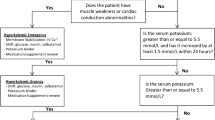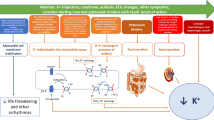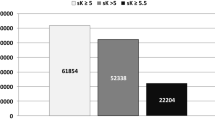Abstract
Hyperkalemia is a frequent clinical abnormality in patients with chronic kidney disease, and it is associated with higher risk of mortality and malignant arrhythmias. Severe hyperkalemia is a medical emergency, which requires immediate therapies, followed by interventions aimed at preventing its recurrence. Current treatment paradigms for chronic hyperkalemia management are focused on eliminating predisposing factors, such as high potassium intake in diets or supplements, and the use of medications known to raise potassium level. Among the latter, inhibitors of the renin-angiotensin aldosterone system are some of the most commonly involved medications, and their discontinuation is often the first step taken by clinicians to prevent the recurrence of hyperkalemia. While this strategy is usually successful, it also deprives patients of the recognized benefits of this class, such as their renoprotective effects. The development of novel potassium binders has ushered in a new era of hyperkalemia management, with a focus on chronic therapy while maintaining the use of beneficial, but hyperkalemia-inducing medications such as renin-angiotensin aldosterone system inhibitors. This review article examines the incidence and clinical consequences of hyperkalemia, and its various treatment options, with special emphasis on novel therapeutic agents and the potential benefits of their application.


Similar content being viewed by others
Reference
Lowrie EG, Lew NL. Death risk in hemodialysis patients: The predictive value of commonly measured variables and an evaluation of death rate differences between facilities. Am J Kidney Dis. 1990;15:458–82.
Iseki K, Uehara H, Nishime K, Tokuyama K, Yoshihara K, Kinjo K, Shiohira Y, Fukiyama K. Impact of the initial levels of laboratory variables on survival in chronic dialysis patients. Am J Kidney Dis. 1996;28:541–8.
Hayes J, Kalantar-Zadeh K, Lu JL, Turban S, Anderson JE, Kovesdy CP. Association of hypo- and hyperkalemia with disease progression and mortality in males with chronic kidney disease: The role of race. Nephron Clin Pract. 2012;120:c8–16.
Kovesdy CP, Regidor DL, Mehrotra R, Jing J, McAllister CJ, Greenland S, Kopple JD, Kalantar-Zadeh K. Serum and dialysate potassium concentrations and survival in hemodialysis patients. Clin J Am Soc Nephrol. 2007;2:999–1007.
Kovesdy CP. Management of hyperkalaemia in chronic kidney disease. Nat Rev Nephrol. 2014;10:653–62.
Fleet JL, Shariff SZ, Gandhi S, Weir MA, Jain AK, Garg AX. Validity of the international classification of diseases 10th revision code for hyperkalaemia in elderly patients at presentation to an emergency department and at hospital admission. BMJ Open. 2012;2.
Einhorn LM, Zhan M, Hsu VD, Walker LD, Moen MF, Seliger SL, Weir MR, Fink JC. The frequency of hyperkalemia and its significance in chronic kidney disease. Arch Intern Med. 2009;169:1156–62.
Drawz PE, Babineau DC, Rahman M. Metabolic complications in elderly adults with chronic kidney disease. J Am Geriatr Soc. 2012;60:310–5.
Bourgoignie JJ, Kaplan M, Pincus J, Gavellas G, Rabinovitch A. Renal handling of potassium in dogs with chronic renal insufficiency. Kidney Int. 1981;20:482–90.
Sarafidis PA, Blacklock R, Wood E, Rumjon A, Simmonds S, Fletcher-Rogers J, Ariyanayagam R, Al-Yassin A, Sharpe C, Vinen K. Prevalence and factors associated with hyperkalemia in predialysis patients followed in a low-clearance clinic. Clin J Am Soc Nephrol. 2012;7:1234–41.
Palmer BF. Managing hyperkalemia caused by inhibitors of the renin-angiotensin-aldosterone system. N Engl J Med. 2004;351:585–92.
Michael JM, Dorner I, Bruns D, Ladenson JH, Sherman LA. Potassium load in CPD-preserved whole blood and two types of packed red blood cells. Transfusion. 1975;15:144–9.
Simmons DH, Avedon M. Acid-base alterations and plasma potassium concentration. Am J Phys. 1959;197:319–26.
DeFronzo RA, Goldberg M, Cooke CR, Barker C, Grossman RA, Agus ZS. Investigations into the mechanisms of hyperkalemia following renal transplantation. Kidney Int. 1977;11:357–65.
DeFronzo RA, Sherwin RS, Felig P, Bia M. Nonuremic diabetic hyperkalemia. Possible role of insulin deficiency. Arch Intern Med. 1977;137:842–3.
Glassock RJ, Goldstein DA, Goldstone R, Hsueh WA. Diabetes mellitus, moderate renal insufficiency and hyperkalemia. Am J Nephrol. 1983;3:233–40.
Tuck ML, Sambhi MP, Levin L. Hyporeninemic hypoaldosteronism in diabetes mellitus. Studies of the autonomic nervous system's control of renin release. Diabetes. 1979;28:237–41.
Arrizabalaga P, Montoliu J, Martinez VA, Andreu L, Lopez PJ, Revert L. Increase in serum potassium caused by beta-2 adrenergic blockade in terminal renal failure: Absence of mediation by insulin or aldosterone. Proc Eur Dial Transplant Assoc. 1983;20:572–6.
Edes TE, Sunderrajan EV. Heparin-induced hyperkalemia. Arch Intern Med. 1985;145:1070–2.
Bismuth C, Gaultier M, Conso F, Efthymiou ML. Hyperkalemia in acute digitalis poisoning: Prognostic significance and therapeutic implications. Clin Toxicol. 1973;6:153–62.
Buhler FR, Burkart F, Lutold BE, Kung M, Marbet G, Pfisterer M. Antihypertensive beta blocking action as related to renin and age: A pharmacologic tool to identify pathogenetic mechanisms in essential hypertension. Am J Cardiol. 1975;36:653–69.
Pedersen EB, Kornerup HJ. Relationship between plasma aldosterone concentration and plasma potassium in patients with essential hypertension during alprenolol treatment. Acta Med Scand. 1976;200:263–7.
Bakris GL, Siomos M, Richardson D, Janssen I, Bolton WK, Hebert L, Agarwal R, Catanzaro D. ACE inhibition or angiotensin receptor blockade: Impact on potassium in renal failure. VAL-K study group. Kidney Int. 2000;58:2084–92.
Weir MR, Rolfe M. Potassium homeostasis and renin-angiotensin-aldosterone system inhibitors. Clin J Am Soc Nephrol. 2010;5:531–48.
Makani H, Bangalore S, Desouza KA, Shah A, Messerli FH. Efficacy and safety of dual blockade of the renin-angiotensin system: Meta-analysis of randomised trials. BMJ. 2013;346:f360.
Susantitaphong P, Sewaralthahab K, Balk EM, Eiam-ong S, Madias NE, Jaber BL. Efficacy and safety of combined vs. single renin-angiotensin-aldosterone system blockade in chronic kidney disease: A meta-analysis. Am J Hypertens. 2013;26:424–41.
Knoll GA, Sahgal A, Nair RC, Graham J, Van WC, Burns KD. Renin-angiotensin system blockade and the risk of hyperkalemia in chronic hemodialysis patients. Am J Med. 2002;112:110–4.
Juurlink DN, Mamdani MM, Lee DS, Kopp A, Austin PC, Laupacis A, Redelmeier DA. Rates of hyperkalemia after publication of the randomized Aldactone evaluation study. N Engl J Med. 2004;351:543–51.
Molnar MZ, Kalantar-Zadeh K, Lott EH, Lu JL, Malakauskas SM, Ma JZ, Quarles DL, Kovesdy CP: ACE Inhibitor and Angiotensin Receptor Blocker Use and Mortality in Patients with Chronic Kidney Disease. J Am Coll Cardiol 2013.
Dittrich KL, Walls RM. Hyperkalemia: ECG manifestations and clinical considerations. J Emerg Med. 1986;4:449–55.
Parham WA, Mehdirad AA, Biermann KM, Fredman CS. Hyperkalemia revisited. Tex Heart Inst J. 2006;33:40–7.
Goyal A, Spertus JA, Gosch K, Venkitachalam L, Jones PG, Van den Berghe G, Kosiborod M. Serum potassium levels and mortality in acute myocardial infarction. JAMA. 2012;307:157–64.
Korgaonkar S, Tilea A, Gillespie BW, Kiser M, Eisele G, Finkelstein F, Kotanko P, Pitt B, Saran R. Serum potassium and outcomes in CKD: insights from the RRI-CKD cohort study. Clin J Am Soc Nephrol. 2010;5:762–9.
Epstein FH. Signs and symptoms of electrolyte disorders. In: Maxwell MH, Kleeman CR, editors. Clinical disorders of fluid and electrolyte metabolism. 3rd ed. New York: McGraw-Hill; 1980. p. 499–516.
Fisch C. Electrolytes and the heart. In: Hurst JW, editor. The heart. New York: McGraw-Hill; 1982. p. 1599.
Kleeman K, Singh BN. Serum electrolytes and the heart. In: Maxwell MH, Kleeman CR, editors. Clinical disorders of fluid and electrolyte metabolism. 3rd ed. New York: McGraw-Hill; 1980. p. 145–80.
Xu Q, Xu F, Fan L, Xiong L, Li H, Cao S, Lin X, Zheng Z, Yu X, Mao H. Serum potassium levels and its variability in incident peritoneal dialysis patients: Associations with mortality. PLoS One. 2014;9:e86750.
Fordjour KN, Walton T, Doran JJ. Management of hyperkalemia in hospitalized patients. Am J Med Sci. 2014;347:93–100.
Scherr L, Ogden DA, Mead AW, Spritz N, Rubin AL. Management of hyperkalemia with a cation-exchange resin. N Engl J Med. 1961;264:115–9.
Emmett M, Hootkins RE, Fine KD, Santa Ana CA, Porter JL, Fordtran JS. Effect of three laxatives and a cation exchange resin on fecal sodium and potassium excretion. Gastroenterology. 1995;108:752–60.
Chernin G, Gal-Oz A, Ben-Assa E, Schwartz IF, Weinstein T, Schwartz D, Silverberg DS. Secondary prevention of hyperkalemia with sodium polystyrene sulfonate in cardiac and kidney patients on renin-angiotensin-aldosterone system inhibition therapy. Clin Cardiol. 2012;35:32–6.
Flinn RB, Merrill JP, Welzant WR. Treatment of the oliguric patient with a new sodium-exchange resin and sorbitol; a preliminary report. N Engl J Med. 1961;264:111–5.
Kamel KS, Wei C. Controversial issues in the treatment of hyperkalaemia. Nephrol Dial Transplant. 2003;18:2215–8.
Kamel KS, Schreiber M. Asking the question again: Are cation exchange resins effective for the treatment of hyperkalemia? Nephrol Dial Transplant. 2012;27:4294–7.
Sterns RH, Rojas M, Bernstein P, Chennupati S. Ion-exchange resins for the treatment of hyperkalemia: Are they safe and effective? J Am Soc Nephrol. 2010;21:733–5.
Gruy-Kapral C, Emmett M, Santa Ana CA, Porter JL, Fordtran JS, Fine KD. Effect of single dose resin-cathartic therapy on serum potassium concentration in patients with end-stage renal disease. J Am Soc Nephrol. 1998;9:1924–30.
Chelcun JL, Sable RA, Friedman K. Colonic ulceration in a patient with renal disease and hyperkalemia. JAAPA. 2012;25:34 .37-34, 38
Gorospe EC, Lewis JT, Bruining DH. Kayexalate-induced esophageal ulcer in a patient with gastroparesis. Clin Gastroenterol Hepatol. 2012;10:A28.
Harel Z, Harel S, Shah PS, Wald R, Perl J, Bell CM. Gastrointestinal adverse events with sodium polystyrene sulfonate (Kayexalate) use: A systematic review. Am J Med. 2013;126:264–24.
Gerstman BB, Kirkman R, Platt R. Intestinal necrosis associated with postoperative orally administered sodium polystyrene sulfonate in sorbitol. Am J Kidney Dis. 1992;20:159–61.
Watson MA, Baker TP, Nguyen A, Sebastianelli ME, Stewart HL, Oliver DK, Abbott KC, Yuan CM. Association of prescription of oral sodium polystyrene sulfonate with sorbitol in an inpatient setting with colonic necrosis: A retrospective cohort study. Am J Kidney Dis. 2012;60:409–16.
US Food and Drug Administration: Kayexalate (sodium polystyrene sulfonate) powder. Safety labeling changes approved by FDA Center for Drug Evaluation and Research (CDER)-September 2009. Available at http://www.fda.gov/Safety/MedWatch/SafetyInformation/ucm186845.htm. Accessed 30 July 2016.
Pitt B, Anker SD, Bushinsky DA, Kitzman DW, Zannad F, Huang IZ. Evaluation of the efficacy and safety of RLY5016, a polymeric potassium binder, in a double-blind, placebo-controlled study in patients with chronic heart failure (the PEARL-HF) trial. Eur Heart J. 2011;32:820–8.
Buysse JM, Huang IZ, Pitt B. PEARL-HF: Prevention of hyperkalemia in patients with heart failure using a novel polymeric potassium binder, RLY5016. Futur Cardiol. 2012;8:17–28.
Weir MR, Bakris GL, Bushinsky DA, Mayo MR, Garza D, Stasiv Y, Wittes J, Christ-Schmidt H, Berman L, Pitt B. Patiromer in patients with kidney disease and hyperkalemia receiving RAAS inhibitors. N Engl J Med. 2015;372:211–21.
Bakris GL, Pitt B, Weir MR, Freeman MW, Mayo MR, Garza D, Stasiv Y, Zawadzki R, Berman L, Bushinsky DA. Effect of patiromer on serum potassium level in patients with hyperkalemia and diabetic kidney disease: The AMETHYST-DN randomized clinical trial. JAMA. 2015;314:151–61.
Packham DK, Rasmussen HS, Lavin PT, El-Shahawy MA, Roger SD, Block G, Qunibi W, Pergola P, Singh B. Sodium zirconium cyclosilicate in hyperkalemia. N Engl J Med. 2015;372:222–31.
Kosiborod M, Rasmussen HS, Lavin P, Qunibi WY, Spinowitz B, Packham D, Roger SD, Yang A, Lerma E, Singh B. Effect of sodium zirconium cyclosilicate on potassium lowering for 28 days among outpatients with hyperkalemia: The HARMONIZE randomized clinical trial. JAMA. 2014;312:2223–33.
Palmer BF, Clegg DJ. Achieving the benefits of a high-potassium, Paleolithic diet, without the toxicity. Mayo Clin Proc. 2016;91:496–508.
Kovesdy CP. Management of Hyperkalemia: An update for the internist. Am J Med. 2015;128:1281–7.
Author information
Authors and Affiliations
Corresponding author
Ethics declarations
Dr. Kovesdy is an employee of the US Department of Veterans Affairs. Opinions expressed in this paper are those of the author’s and do not represent the opinion of the US Department of Veterans Affairs.
Conflicts of interest
Dr. Kovesdy received consultant fees from Relypsa (manufacturer of Patiromer) and ZS Pharma (manufacturer of zirconium cyclosilicate).
Rights and permissions
About this article
Cite this article
Kovesdy, C.P. Updates in hyperkalemia: Outcomes and therapeutic strategies. Rev Endocr Metab Disord 18, 41–47 (2017). https://doi.org/10.1007/s11154-016-9384-x
Published:
Issue Date:
DOI: https://doi.org/10.1007/s11154-016-9384-x




